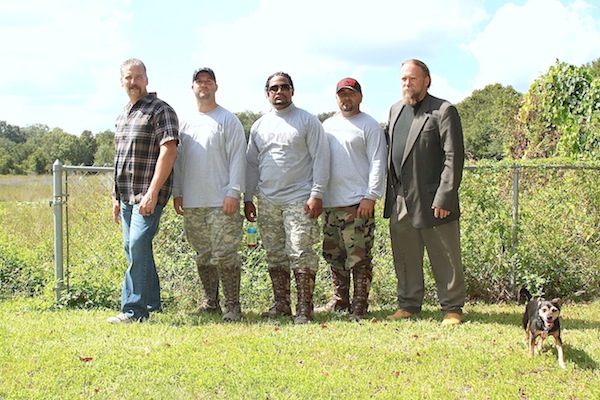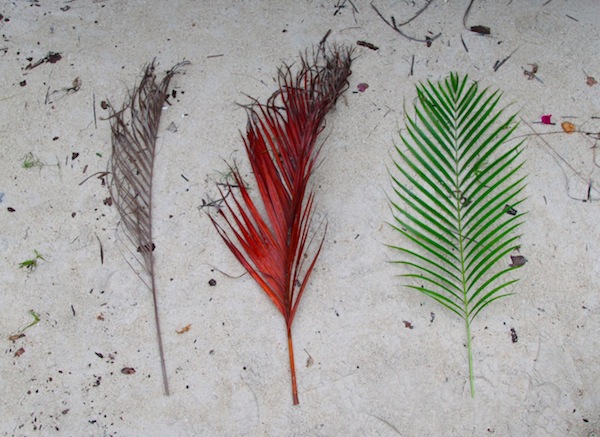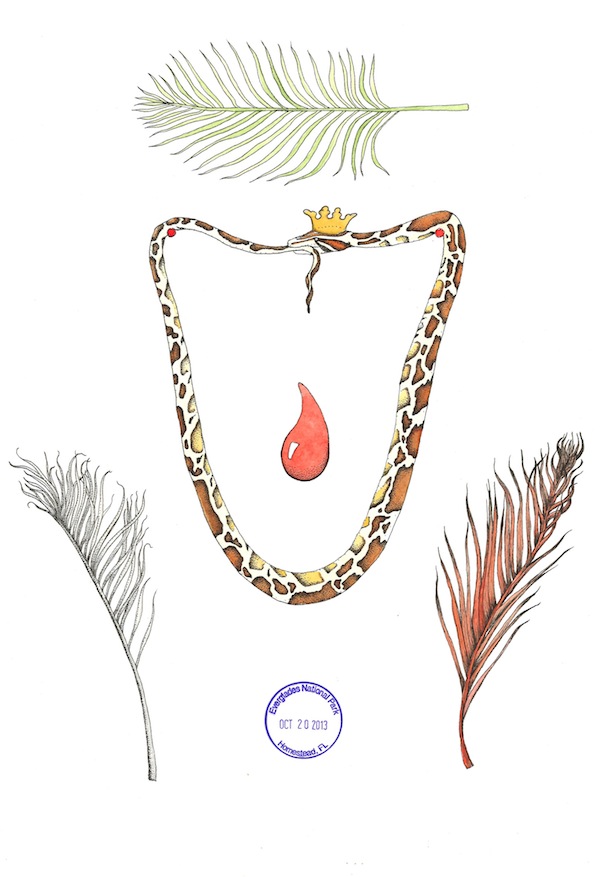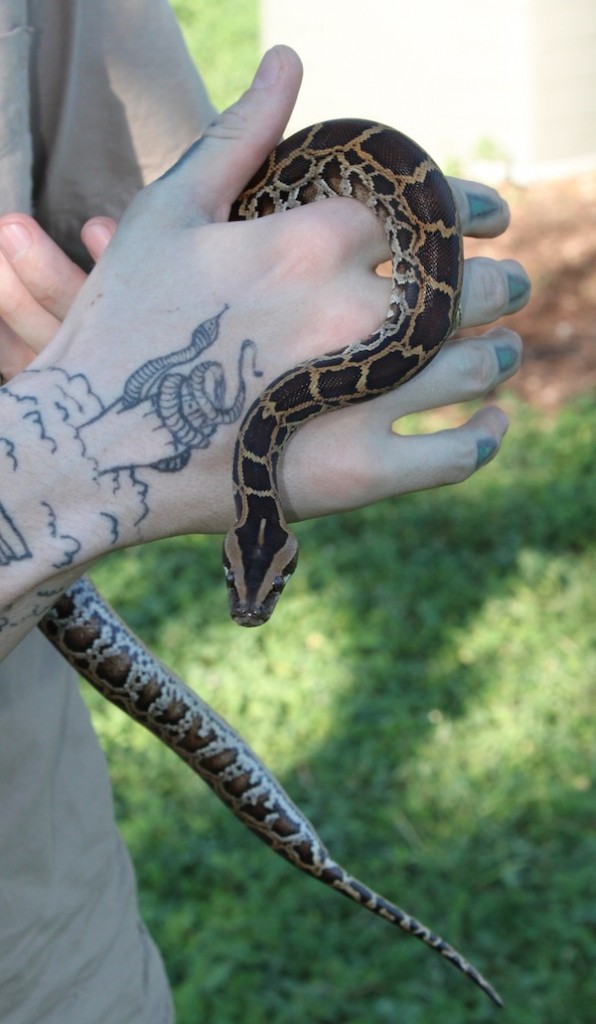
AIRIE Diary: An itinerant Artist in Residence
By Bryan McGovern Wilson, AIRIE
On October 1st, 2013, the Federal government initiated a series of closures for the entire United States, suspending and furloughing many federally run programs, institutions and their employees. The National Parks fell within the crosshairs of this government shutdown. Access was cut off to the Everglades National Park and the Artist in Residence in Everglades program was suspended.
As the designated Artist in Residence for the month of October, I suddenly found myself having the unique distinction of being the first Itinerate Artist in Residence. I learned about the shutdown days before I was to depart for Florida from New York City and begin the work of meeting with volunteers, biologists, and others engaged with the land. Despite the setback, I was determined to make my way south and continue the proposed project in a somewhat modified form. The unknowns only heightened the romance of a wilderness adventure.
My initial intent for the residency was to investigate the invasive exotic reptile and snake populations, specifically the Burmese python, which have devastated the park’s biodiversity and destabilized the overall park ecosystem. The issue spoke to many enduring interests within my own artistic practice: themes such as the human-made impacts upon the land and the cultures that emerge from ecological stewardship. There is also a theatricality to the python, echoed in our historical use of the serpent in imagery, fables, and propaganda that I was hoping to explore as a guiding force in my field work.
The Everglades National Park, the first national park to be established on the basis of sustaining and protecting the native biodiversity in the region, currently faces an identity crisis with an invasive exotic species such as the python. If the core principle of the park is to maintain the native biodiversity within it, to what extent must park officials go to maintain that ideal? Burmese pythons and other thriving exotic reptiles are only one of many invasive plants and animals that threaten the diversity of the land, while taxing the limited resources of the park.
Strangely enough, the Burmese python is considered a “threatened” species in its native habitat of South and Southeastern Asia. Does the Park Service have a responsibility to manage these animals? When do they stop being referred to as the Burmese python and become the American python?



The Swamp Apes
Before my journey to the park, I had been corresponding with many people who were passionate about the python problem as a part of their professional research, or in their capacity as a concerned volunteer. When I arrived in Miami, I found the art community, park volunteers and art patrons welcoming me with an interim residence, as well as generosity and warmth. This hospitality continued on into my interactions with Tom Rahill, founder of the “The Swamp Apes,” a volunteer group of python hunters comprised mostly of military veterans of Iraq and Afghanistan. They use the hunts as a means of coping with Post Traumatic Stress Disorder (PTSD), Traumatic Brain Injuries (TBI), and physical trauma.
Before getting to know Tom and The Swamp Apes, I had visions in my mind of a group of hyper masculine guys who went out in to the park, killing snakes for the thrills that they missed from active combat. Indeed, I held to this belief so strongly that I braced myself for having to witness, or even take part in, the killing of one of these animals. Equipped with two sizable knives a friend had offered me and my own personal one that I always carry with me, I was ready for action. Quickly, I realized how foolish I had been. Instead of a group of bloodthirsty, insular hunters, I found a highly organized group of dedicated volunteers who were able to talk eloquently about the ecosystem and our responsibility to it as stewards, striving to find sustainable therapeutic outlets for their emotional and physical struggles.
Killing of the pythons was something that was to be avoided at all costs in the field, something that all involved loathed to partake in. Under the leadership of Tom, all successfully caught pythons are photographed, GPS coordinates are logged, and basic biometric data are gathered from the animal before it is handed over to lab biologists for humane euthanizing. A number of the people I interviewed who hunted pythons had chosen to become vegetarian, based on a desire to alleviate general animal suffering.
After tagging along on several python hunts, evidence of the therapeutic results for members of The Swamp Apes was undeniable. A common condition for veterans from volatile war environments is a loss of one’s purpose, the exhilaration of doing meaningful work and group camaraderie. The intense focus and team effort necessary for the python hunts provides an outlet for skills that fester in civilian life in a new and meaningful way. As one member remarked, “I used to have nightmares about war…now I dream of pythons!”

Burmese Python, America Ecosystem
Of course, invasive exotics are unaware of their impact upon the ecosystem. We as humans apply identity and meaning upon plants and animals that flourish in areas that we find undesirable. In particular, snakes and serpents have long been a creature that we project a wide spectrum of meaning upon. This is most prevalent in the mythologies and symbols that incorporate serpents as their focus. We assign the snake as an icon of rebirth and wisdom, as shorthand for Satan’s influence, as the familiar of witches and the dark arts, as erotic symbol and patriotism. The serpent, as an archetype, highlights the very human condition of attraction and repulsion, an implicate marker of our own ambivalent relationship to nature and our desire to make that anxiety mean something.
There is a sense of hopelessness inherent to combating invasive species. Like many large shifts in ecosystems that are the direct result of human intervention, by the time the problem can be clearly identified, it’s grown too large to address fully. There is an acceptance amongst all involved with ecological stewardship that comprehensive rehabilitation of a given ecosystem is ultimately a failing proposition. Despite whatever programs, data, and strategies employed to combat the issues related to invasive species, there simply are not enough resources and manpower to eradicate all invasive exotic snakes and reptiles, much less the entire scope of invasive plants and animals found in our National Parks.
Given this reality, the dedication and enthusiasm found in the volunteers and professionals engaged with mitigating this problem is all the more impressive and inspiring. Education and community outreach seem to be the strategy that gives these ecological stewards the best use of limited dollars. A strong case can be made that invasive plant species, such as the Brazilian Pepper, are damaging the Everglades more than any python ever could, our attraction to these large snakes grabs our attention. These are big, beautiful animals that evoke primal fight or flight reactions. People get excited about large snakes in a way that they don’t for a leafy vine. In a way, the Burmese python has been an unexpected asset to the general public conversation about people’s responsibilities to their environment and the impact their action/inaction has upon it.

My 2013 Python Challenge
On January 12, 2013, the Florida Fish and Wildlife Conservation Commission hosted “2013 Python Challenge,” an annual competition to hunt Burmese pythons in and around the Everglades for the general public. There are cash prizes for the team that catches the most snakes, as well as the largest python. When I learned about the competition, I can’t help but think of an episode of The Simpson’s in which the residents of Springfield prepare for “Whacking Day”: the event where the citizens enthusiastically hunt and club snakes found in Springfield. Luckily, Lisa Simpson stands up to the townsfolk’s indiscriminate snake slaughter, and with the help of an impromptu Barry White performing a sexy snake song; everyone learns to find some compassion for their slithery brethren.
While “Python Challenge” does not encourage the wanton killing of all snakes, it is a clever outreach program to encourage the public to participate in managing the exploding populations of pythons and dispels misperceptions of the animals. Though these annual Python Challenges will not effectively control the invasive reptiles within the Everglades on their own, participants come away with a deeper understanding of what managing this species looks like. Less about guns and big knives, more data gathering and safe practices, the challenge can be viewed as a sustainable success. It is ever the goal for those championing social, environmental, or political reform to create a self-regulating community and education, in its many forms, is the best agent of change.
So what can an artist like myself contribute to this conversation? Hard to say for sure at this time, but I suspect it has to do with engaging the public. Fundamentally, to make art is to engage others through expressive means. An artistic practice can open people up to ideas, or bring awareness of a concept to a broad spectrum of people. Art has the unique ability to function on multiple levels simultaneously and opens itself to the interpretation of the individual.
As an artist, I love using a variety of disciplines and mediums to engage an audience. I seek out places, histories, and conditions that are multifaceted and serve as models for larger human conditions. There are exciting moments here I’ve been able to capture with my camera, fundamentals of drawing and watercolor that feel new and dynamic, and potential sculptural works that will test my technical and conceptual abilities. I also hope from my work here that viewers can access the snake as an icon, or sees themselves in the volunteers working to address ecological crises, or gains some agency over their role as a member of a grander system of connections.
Overall, I am very clear that my time in South Florida is the first of many for this emergent project and one I look forward to expanding. I am deeply grateful to those who were so welcoming to me, generous with their time and knowledge in the service of the early stages of this endeavor. I cannot express how meaningful the support of Christy Gast, The Fountainhead Residency, Tom Rahill, and Kevin Bowles-Mohr have been throughout my time in Southern Florida. In addition, I’d like to thank Skip Snow, Jeffrey Fobb, Wayne Rassner, Deborah Mitchell, Cesar Sanchez, Barry Offenburger, and Jorge Martinez for sharing their time and expertise with me.


Recent Content
-
Artsarticle ·
-
Artsarticle ·
-
Artsarticle ·
